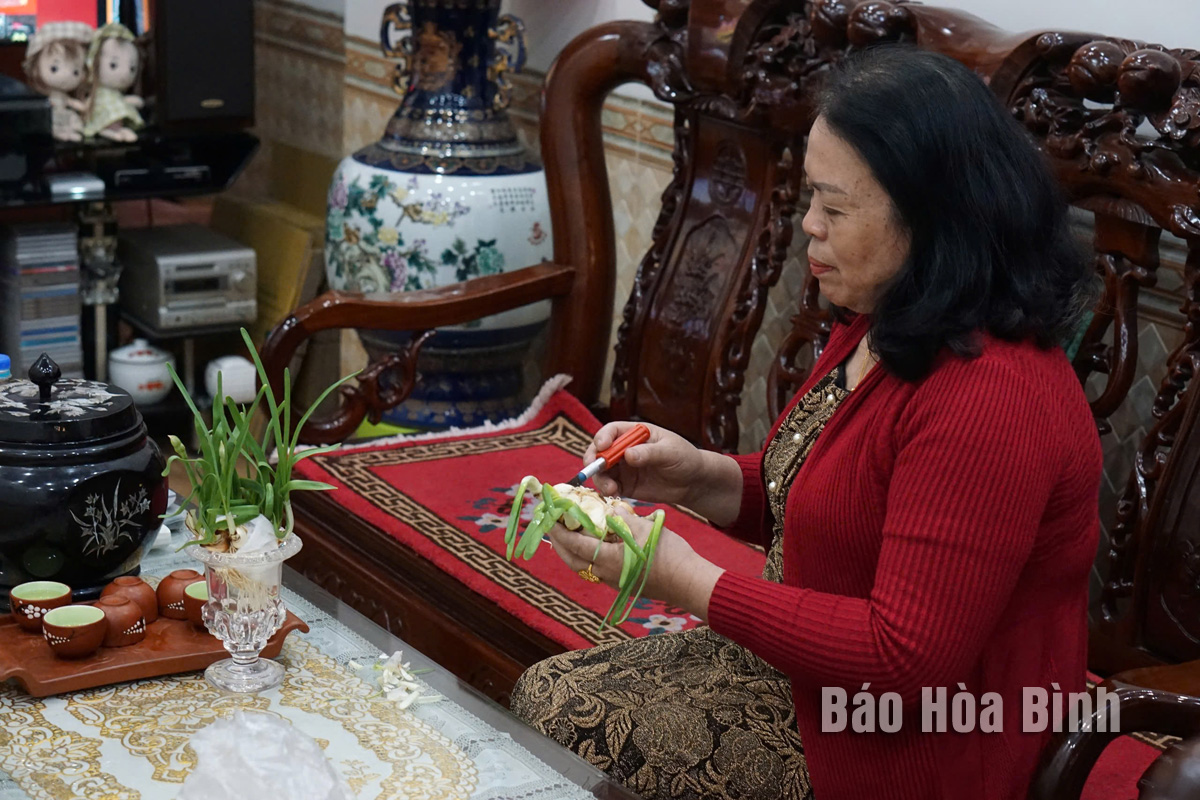
When it comes to springtime blooms, many are familiar with the vibrant pink of peach blossoms in northern Vietnam or the golden hue of apricot flowers in the south. However, there is another elegant bloom that once held sway in the historic capital of Thang Long – Hanoi, known in bygone days as Ke Cho. The pure and pristine narcissus flower, a harbinger of the Lunar New Year (Tet), is making a comeback, and its story is as captivating as its beauty.
Do Thi Phu in Hoa Binh city cares for narcissus flowers ahead of the Tet
holiday.
In today life, narcissus flowers have become more accessible to everyone,
partly due to their affordable price and because they are no longer confined to
Hanoi but have followed the footsteps of its residents to various cities and
provinces. Do Thi Phu, a Hanoi native who has been living and working in Hoa
Binh city since 1970, is one of the many people keeping this tradition alive.
Whenever the 12th lunar month comes, she seeks out Chuong Chau narcissus bulbs
for display during Tet.
According to her, the most important aspect of pruning narcissus flowers is to
avoid damaging the floral sheath as this would prevent the flowers from
blooming. Her preference lies with the single-petaled bulb variety. She
explained: "In the old days, especially during the early days of Tet, people
always wished for everything to 'rise up' and be five to ten times better than
the previous year. However, double-petaled narcissus flowers tend to bow their
heads downward, unlike single-petaled ones that stand upright. The elders
believed this posture was incomplete and less auspicious. Regarding fragrance,
single-petaled flowers emit a gentle and subtle aroma that blends harmoniously
with the scent of incense and the festive Tet atmosphere, offering a sense of
relaxation and comfort. In contrast, double-petaled flowers, while fragrant,
produce a stronger, more overwhelming scent that feels heavier and less
compatible with the Vietnamese preference for lightness and freshness".
In recent years, the tradition of cultivating narcissus flowers has gradually
gained traction among Hoa Binh residents, making these blooms a favoured choice
for Tet decorations. Local plant shops in Hoa Binh city have also begun
offering narcissus bulbs as part of their product range.
The art of appreciating narcissus flowers, dating back to the early 20th
century, is mentioned in various literary works, such as "Tet Viet Nam xua”
(Old Vietnamese Tet) by scholar Nguyen Tien Lang and the essay "To hoa" by
renowned writer Nguyen Tuan.
It can be said that thanks to its inherent beauty and deep connection with Tet,
along with improving material and spiritual lives, the tradition of narcissus
flower appreciation continues to thrive. Over time, it has become more popular
and is spreading more strongly than ever.
With an increasingly vibrant and widespread emulation movement aimed at building cultured residential areas and cultured families, Yen Thuy District has been making steady progress toward improving both the material and spiritual well-being of its people, while fostering a civilized, prosperous, beautiful, and progressive community.
Once lacking recreational spaces and community facilities, Residential Group 2 in Quynh Lam Ward (Hoa Binh City) has recently received attention for the construction of a new, spacious, and fully equipped cultural house. The project followed the model of state support combined with public contributions in both labor and funding.
The "All people unite to build cultural life" movement, which has been effectively integrated with Kim Boi district’s socio-economic development goals, is fostering a lively spirit of emulation across local residential areas, hamlets, villages, public agencies, and enterprises. In addition, through the initiative, traditional cultural values are being preserved and promoted, while community solidarity and mutual support in poverty reduction and economic development are being strengthened.
A working delegation of the Hoa Binh provincial People’s Committee led by its Permanent Vice Chairman Nguyen Van Toan on June 11 inspected the progress of a project to build the Mo Muong Cultural Heritage Conservation Space linked to tourism services in Hop Phong commune, Cao Phong district.
Born and growing in the heroic land of Muong Dong, Dinh Thi Kieu Dung, a resident in Bo town of Kim Boi district, in her childhood was nurtured by the sweet lullabies of her grandmother and mother. These melodies deeply imprinted on her soul, becoming an inseparable part of her love for her ethnic group's culture. For over 20 years, this love for her hometown has driven Dung to research, collect, and pass down the cultural values of the Muong people to future generations.
In the final days of May, the Ethnic Art Troupe of Hoa Binh Province organized performances to serve the people in remote, mountainous, and particularly disadvantaged areas within the province. These were not just ordinary artistic shows, but they were the meaningful journeys aimed at spreading cultural values, enhancing the spiritual life of the people and contributing to the preservation of ethnic minority cultural identities.



